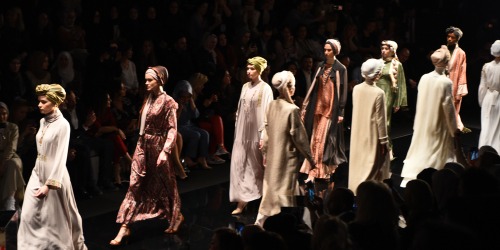SGIE Report 2024/25: Innovation, sustainability injects impetus in modest fashion
The global modest fashion industry recorded tepid growth in recent months, with Muslim consumer spending on apparel and footwear rising 3% year-on-year to reach $327 billion in 2023, according to the State of the Global Islamic Economy (SGIE) Report 2024/25.
Projections are optimistic though, with spending expected to reach $433 billion by 2028, at a CAGR of 5.8%. Iran, Türkiye, and Bangladesh lead in Muslim consumer spending on apparel, while OIC-based modest clothing businesses continue to expand internationally. Investments in the space were modest as well, accounting for close to 1% of the total investment pool across other sectors.
Innovation, social commerce emerge as differentiators
Innovation is shaping the sector, with new products like hijab jewelry, 3D-printed hijab undercaps, and modest medical scrubs gaining traction.
Modest activewear remains in high demand, while Ramadan collections continue to be a key focus for mainstream brands.
Premium modest clothing brands are leveraging experiential marketing to enhance brand engagement, while the second-hand clothing market is expanding due to sustainability concerns and evolving consumer preferences.
Social commerce is thriving, predominantly across the Asian region, where platforms like Shopee Live and TikTok Shop are shaping engagement. Social media is also driving trends and increasing visibility of modest clothing stylists and influencers.
Events, programs back sector growth
The rise of modest fashion is evident in the increasing number of dedicated fashion weeks and events worldwide, according to the SGIE report. The presence of modest fashion in mainstream fashion weeks further underscores its growing influence.
Meanwhile, incubators, conferences, and training programs are enhancing business knowledge in the sector.
Sustainability injects impetus
Sustainable textile innovation is advancing, presenting multiple opportunities, such as leveraging artificial intelligence (AI) tools to enhance marketing, expanding sourcing beyond China, and addressing the demand for modest sportswear.
However, for the sector to witness continued momentum, stakeholders must take strategic action. Investors can shift their focus and funds on developing clothing manufacturing industries within OIC countries. Governments can drive progress through incentives such as schemes and tax reductions on sustainable apparel.
For continued momentum, businesses should adopt AI-driven marketing strategies, explore alternative sourcing, invest in modest sportswear, and recognize the growing influence of modest fashion stylists.
To download a copy of the State of the Global Islamic Economy Report 2024/25, click here.

Salaam Gateway